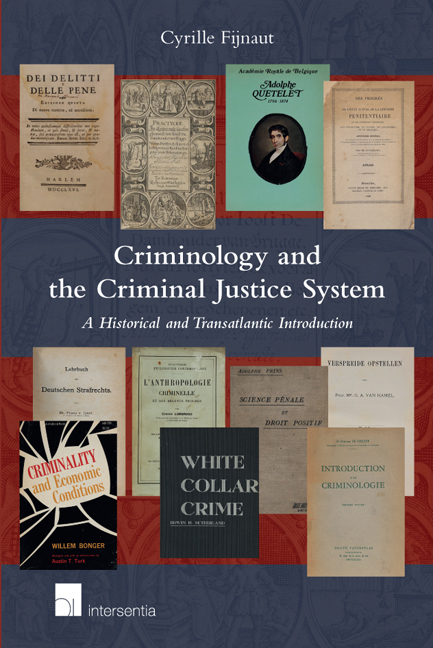Book contents
- Frontmatter
- Preface
- Contents
- Chapter 1 General Introduction
- Chapter 2 Origin of the Present-Day Criminal Justice System
- Chapter 3 Restructuring of the Criminal Justice System During the Enlightenment and the French Period
- Chapter 4 Emergence of the Scientific Study of Crime, Criminals, and the Combatting of Crime
- Chapter 5 Establishment of Criminology in Italy and France
- Chapter 6 Development of Criminology in German-Speaking Europe and the United Kingdom
- Chapter 7 Establishment of Criminology in the Netherlands and Belgium
- Chapter 8 Ideologisation of Criminology in the Third Reich and the Soviet Union
- Chapter 9 Reception of European Criminology in the United States
- Chapter 10 Transatlantic Integration of Criminology
- Chapter 11 General Conclusion
- Bibliography
- Register of Names
Chapter 2 - Origin of the Present-Day Criminal Justice System
Published online by Cambridge University Press: 11 October 2018
- Frontmatter
- Preface
- Contents
- Chapter 1 General Introduction
- Chapter 2 Origin of the Present-Day Criminal Justice System
- Chapter 3 Restructuring of the Criminal Justice System During the Enlightenment and the French Period
- Chapter 4 Emergence of the Scientific Study of Crime, Criminals, and the Combatting of Crime
- Chapter 5 Establishment of Criminology in Italy and France
- Chapter 6 Development of Criminology in German-Speaking Europe and the United Kingdom
- Chapter 7 Establishment of Criminology in the Netherlands and Belgium
- Chapter 8 Ideologisation of Criminology in the Third Reich and the Soviet Union
- Chapter 9 Reception of European Criminology in the United States
- Chapter 10 Transatlantic Integration of Criminology
- Chapter 11 General Conclusion
- Bibliography
- Register of Names
Summary
INTRODUCTION
In the course of the eighteenth century, the criminal justice system – as the main form of combatting crime – became one of the objects of critical discussion regarding the organisation and operation of the nation state. Needless to say, that discussion assumed that the audience addressed would have the necessary prior knowledge of the European political situation regarding these points, or at least the situation in certain European countries. That assumption was probably justified at the time, but it certainly does not apply to readers today.
To ensure a proper understanding of that discussion, this chapter therefore explains some of the main developments that occurred in Europe during the Middle Ages and the early modern period. In particular, an outline is given of how criminal proceedings at the time came to be on an inquisitorial basis and how – in line with that important procedural transformation – a criminal justice system was constructed of which the police force, the judiciary, and the prison system still form the institutional backbone today. Based on one of the best-known Dutch pamphlets from around the year 1600 on tackling the problems of crime – Dirk Volckertszoon Coornhert's Boeventucht [Discipline of Villains] – an explanation is given of the discussion associated with the emergence of the modern criminal justice system.
Discussing this large-scale institutionalisation of inquisitorial criminal procedure also provides an opportunity to give a taste of the debate taking place in historical criminology and in research on the history of criminal law about important issues such as the establishment of today's prison system and the modernisation of the police.
TRANSITION FROM ACCUSATORY TO INQUISITORIAL CRIMINAL PROCEEDINGS
Entirely in line with Carolingian criminal law, the “new” medieval state and city criminal law was initially of a predominantly accusatory nature. In the thirteenth, fourteenth, and fift eenth centuries, however, it acquired throughout Europe – in some places under the influence of canon law – an increasingly inquisitorial character, at least as regards more serious forms of crime. For less serious off ences, accusatory methods for keeping the peace within the community remained current in many places, right up to the French Revolution.
- Type
- Chapter
- Information
- Criminology and the Criminal Justice SystemA Historical and Transatlantic Introduction, pp. 9 - 26Publisher: IntersentiaPrint publication year: 2017



